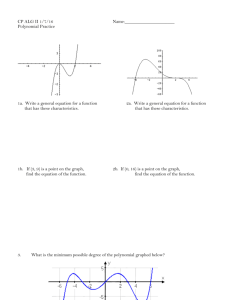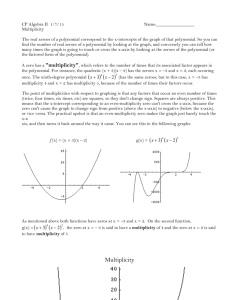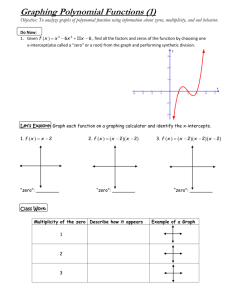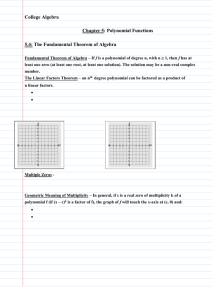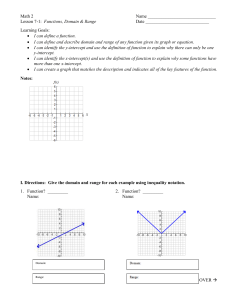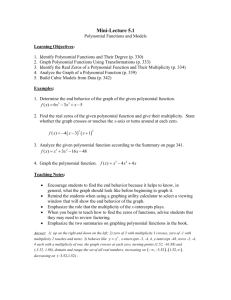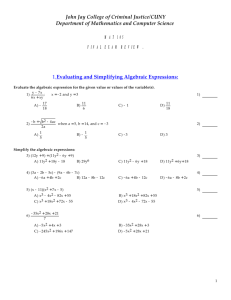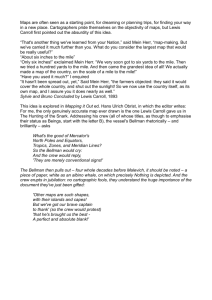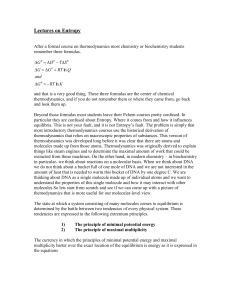Math 3 Name Module 3 Test Review Period: ______ What type of
advertisement
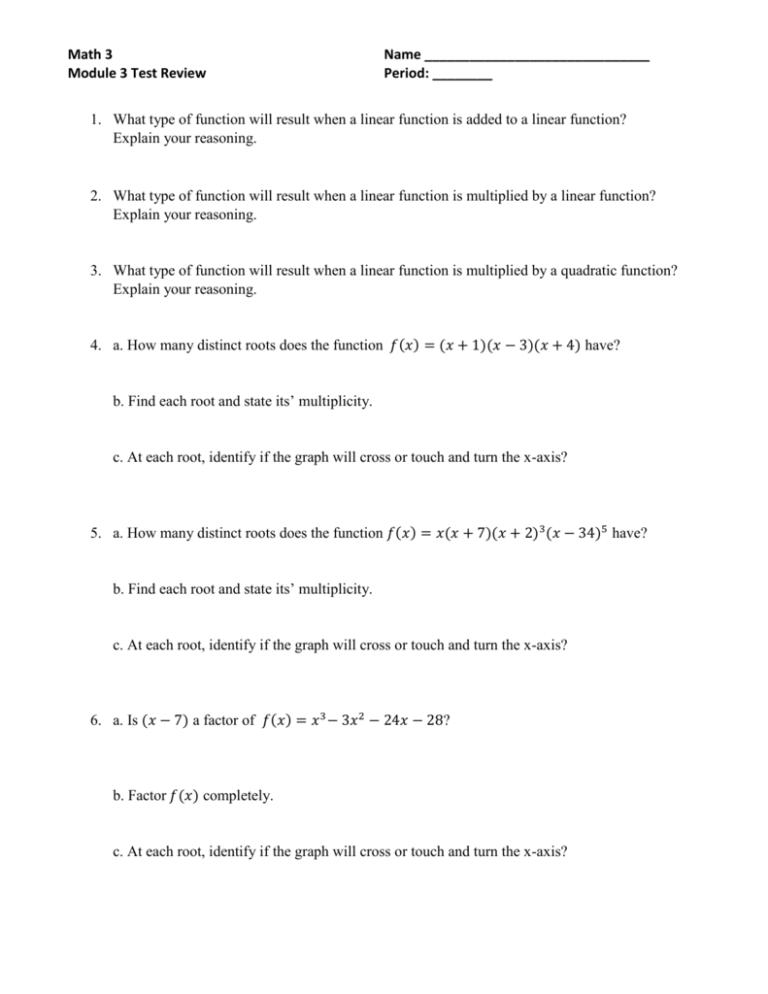
Math 3 Module 3 Test Review Name ______________________________ Period: ________ 1. What type of function will result when a linear function is added to a linear function? Explain your reasoning. 2. What type of function will result when a linear function is multiplied by a linear function? Explain your reasoning. 3. What type of function will result when a linear function is multiplied by a quadratic function? Explain your reasoning. 4. a. How many distinct roots does the function 𝑓(𝑥) = (𝑥 + 1)(𝑥 − 3)(𝑥 + 4) have? b. Find each root and state its’ multiplicity. c. At each root, identify if the graph will cross or touch and turn the x-axis? 5. a. How many distinct roots does the function 𝑓(𝑥) = 𝑥(𝑥 + 7)(𝑥 + 2)3 (𝑥 − 34)5 have? b. Find each root and state its’ multiplicity. c. At each root, identify if the graph will cross or touch and turn the x-axis? 6. a. Is (𝑥 − 7) a factor of 𝑓(𝑥) = 𝑥 3 − 3𝑥 2 − 24𝑥 − 28? b. Factor 𝑓(𝑥) completely. c. At each root, identify if the graph will cross or touch and turn the x-axis? 7. What is the function with the given roots of 2 and -5? 8. What is the function with a root at 3 with multiplicity of 2 and another root at -4? 9. What is the function with a root at -5 with multiplicity of 3, root 2 with multiplicity of 2 and a root at 0 with multiplicity of 1? Write in factored form. 10. What is the end behavior of the function? a. 𝑓(𝑥) = (𝑥 − 3)(𝑥 − 5)(2 − 𝑥) b. End Behavior 𝐴𝑠 𝑥 → −∞ 𝑓(𝑥) →________ 𝐴𝑠 𝑥 → ∞ 𝑓(𝑥) →__________ 𝑔(𝑥) = (𝑥 + 2)2 (𝑥 + 6) End Behavior 𝐴𝑠 𝑥 → −∞ 𝑓(𝑥) →________ 𝐴𝑠 𝑥 → ∞ 𝑓(𝑥) →__________ c. ℎ(𝑥) has a root at -3, another root at 5 with multiplicity of 2. Write the function h(x) and state the end behavior. Function: End Behavior 𝐴𝑠 𝑥 → −∞ 𝑓(𝑥) →________ 𝐴𝑠 𝑥 → ∞ 𝑓(𝑥) →__________ Use the given functions to perform the indicated operations. 𝑓(𝑥) = 𝑥 + 6 𝑔(𝑥) = 3𝑥 − 1 ℎ(𝑥) = 𝑥 2 + 4𝑥 − 5 11. 𝑓(𝑥) + 𝑔(𝑥) 12. 𝑔(𝑥) − 𝑓(𝑥) 14. 𝑓(𝑥) ∗ 𝑔(𝑥) 15. ℎ(𝑥) ∗ 𝑔(𝑥) 13. 𝑔(𝑥) − ℎ(𝑥) 16. State the type of function that resulted from problems 11-15. (Linear, Quadratic, Cubic, Exponential) 11: _____________ 14: ___________ 12:_____________ 15: ___________ 13: _____________ 17. Find the x-intercepts and state the multiplicity of each factor, find the y-intercept and the end behavior. Graph the Polynomial using this information. 𝑓(𝑥) = (𝑥 + 3)(𝑥 − 2)(𝑥 + 1) x-intercept(s): Multiplicity of each factor: y-intercept: End Behavior 𝐴𝑠 𝑥 → −∞ 𝑓(𝑥) →________ 𝐴𝑠 𝑥 → ∞ 𝑓(𝑥) →________ 18. Find the x-intercepts and state the multiplicity of each factor, find the y-intercept and the end behavior. Graph the Polynomial using this information. 𝑓(𝑥) = (𝑥 − 1)(𝑥 2 − 6𝑥 + 9) x-intercept(s): Multiplicity of each factor: y-intercept: End Behavior 𝐴𝑠 𝑥 → −∞ 𝑓(𝑥) →________ 𝐴𝑠 𝑥 → ∞ 𝑓(𝑥) →________ 18. Find the x-intercepts and state the multiplicity of each factor, find the y-intercept and the end behavior. Graph the Polynomial using this information. 𝑓(𝑥) = 𝑥 3 + 6𝑥 2 + 11𝑥 + 6 , one root is -1. x-intercept(s): Multiplicity of each factor: y-intercept: End Behavior 𝐴𝑠 𝑥 → ∞ 𝑓(𝑥) →________ 𝐴𝑠 𝑥 → −∞ 𝑓(𝑥) →________ 17. Find the missing information given the x-intercepts and graph the function. Equation: 𝑓(𝑥) = x-intercept(s): 2 with multiplicity of 1, -3 with multiplicity of 1, and 1 with multiplicity of 2 y-intercept: End Behavior 𝐴𝑠 𝑥 → ∞ 𝑓(𝑥) →________ 𝐴𝑠 𝑥 → −∞ 𝑓(𝑥) →________ 18. A polynomial with rational roots has the following zeros. Find the remaining zeros. a. 3, 4 − √3 b. 2√5 , 0 , −6 + 3√11 c. -5, 2, 2 + 3i 19. Find all the roots of the polynomial if one is given. 𝑓(𝑥) = 2𝑥 3 + 3𝑥 2 − 65𝑥 + 84 ; x = 4 20. Find all the factors of the polynomial if one is given. 𝑓(𝑥) = 𝑥 3 − 𝑥 2 − 11𝑥 + 3; (x+3)


